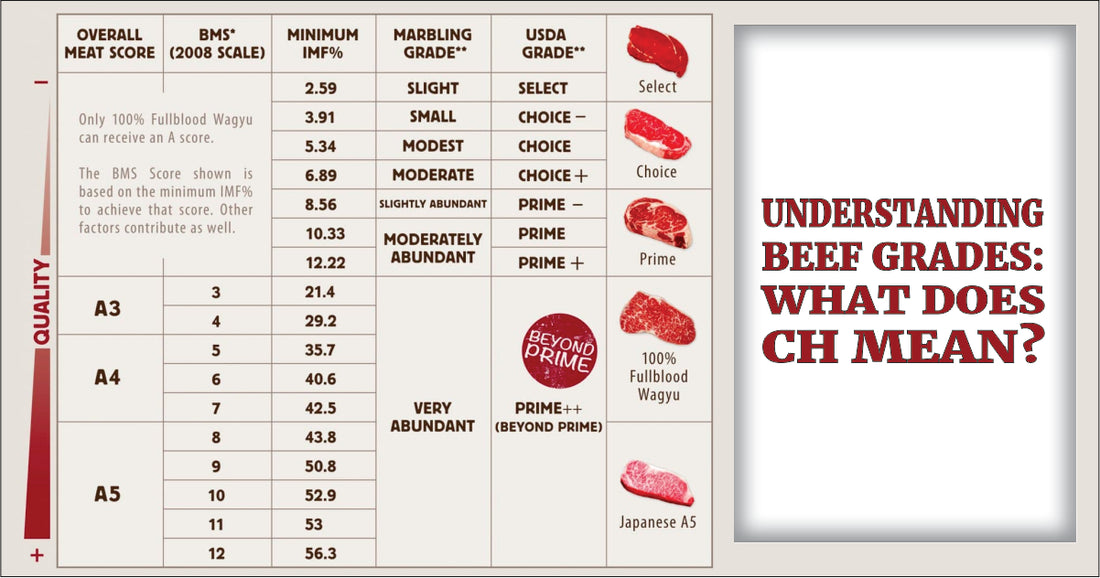
Understanding Beef Grades: What Does CH Mean?
Carolina Cattle CompanyShare
Introduction
When purchasing beef, you've likely come across terms like "Prime," "Choice," or "Select" on the packaging, but what do they mean? These labels are part of the USDA grading system, which helps consumers understand the quality of the meat they're buying. In particular, "CH" or "Choice" is a standard grade found in supermarkets, representing a balance between quality and affordability. This blog post will explain beef grading, focusing on what "CH" means and why it plays an important role in your meat selection.What Is Beef Grading?
Beef grading is a system established by the United States Department of Agriculture (USDA) to assess beef quality based on specific characteristics. This grading system helps consumers make informed choices by indicating the meat’s tenderness, juiciness, and flavor potential. There are three primary USDA grades that you may encounter:- Prime: The highest quality, with abundant marbling and tenderness.
- Choice: A step below Prime but still offers good marbling and flavor.
- Select: Leaner than Choice, with less marbling, making it less juicy and flavorful.
What Does CH (Choice) Mean?
"CH" stands for "Choice" in the USDA grading system. It refers to beef with less marbling than Prime but still provides a delicious eating experience. The marbling in Choice-grade beef ensures it has enough fat to create a juicy, tender steak without being overly rich. This makes it a popular option for home cooks and restaurants, offering a great balance between quality and cost.Key Characteristics of CH (Choice) Beef:
-
Moderate Marbling: The fat is evenly distributed, making the meat tender and flavorful.
-
Affordable: Choice beef is more budget-friendly than Prime but still offers excellent taste and texture.
-
Versatility: Ideal for grilling, roasting, or pan-searing, making it a versatile choice for many recipes.
Why Does Beef Grading Matter?
Understanding beef grading is essential for several reasons. It helps consumers pick the proper cut for their needs, whether for a special occasion or an everyday meal. Grading also provides insights into:
-
Tenderness: Higher grades like Prime and Choice will be more tender due to the fat content.
-
Flavor: Marbling directly impacts flavor, with more marbling producing richer, juicier beef.
-
Cooking Method: Certain cuts, especially those with lower grades, might need longer, slower cooking methods to ensure tenderness.
USDA Grading Process: How Is Beef Evaluated?
The USDA evaluates beef carcasses based on two main factors:- Degree of Marbling: This is the amount of intramuscular fat in the meat. More marbling generally means more flavor and juiciness. Prime beef has the most marbling, followed by Choice and Select.
- Maturity of the Beef: This refers to the cow's age when it was slaughtered. Younger cattle typically produce more tender meat, which influences its grade.
How Does Marbling Affect Beef Grading?
Marbling plays a significant role in the beef grading process, as it impacts both flavor and tenderness. Fat within the muscle fibers melts during cooking, which creates the juiciness and rich flavor we associate with higher-quality beef. Here’s how marbling affects the grades:-
Prime: Abundant marbling, leading to the most tender, juicy, and flavorful steaks. Best suited for high-heat, quick-cooking methods like grilling.
-
Choice: Moderate marbling provides a balance of tenderness and flavor. Ideal for grilling, broiling, or pan-searing.
-
Select: Little marbling, resulting in a leaner, less juicy cut. This grade benefits from slow cooking methods like braising or stewing to add moisture.
For a detailed look at how marbling and other factors influence grading, refer to a beef quality grading chart, which outlines the differences between the grades.
Tips for Cooking Choice-Grade Beef
To get the most out of your Choice-grade beef, here are a few tips:-
Choose the Right Cut: Flat iron, ribeye, and New York strip are excellent cuts that balance flavor and tenderness when you go with Choice beef.
-
Season Generously: Salt the meat well before cooking to enhance the beef's natural flavors.
-
Cook to Medium-Rare: Overcooking Choice beef can dry it out. Aim for medium-rare to keep it juicy.
-
Let It Rest: Always allow your steak to rest for a few minutes after cooking to retain juices.
